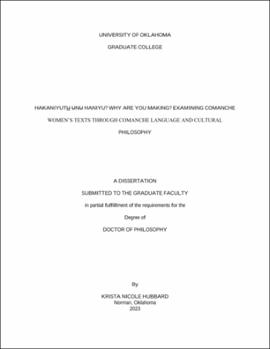| dc.description.abstract | One can examine Comanche women’s spoken stories in the Comanche language for
cultural and philosophical insight through the metaphor of oiling and braiding one’s hair because
oil (or yuhu, pronounced “you” in Comanche, meaning the nouns, oil, grease, lard, or fat) has
historical roots in Comanche culture, where women would use yuhu to braid their hair to adorn
themselves, to keep their hair free from their faces, to function while they cared for their
families, to ready themselves for battle, or to protect their hair from lice. The metaphor of oiling
and braiding hair helps us understand the culture and philosophy behind Comanche women’s
stories because yuhu is homphonically related to yu (also pronounced you), which has a plethora
of grammar functions and variations. Generally, the prefix, yu-, means to “do right,” but the
suffix version, -yu, serves as a progressive verb marker. My study argues for a rhetorical yu by
collectively examining the various yu forms and their relationships to narrative in Comanche
women’s stories. Like the oil yuhu in braids, yu binds and weaves a story to move the plot along.
The sentence, hakaniyutu unu yuhaniyu, meaning “Why are you making?” or “How do you make
right?” best conveys not only yu’s ability to weave meaning at the sentence level, but also its
fluidity in meaning, indicating its linguistic woven-ness, or braid-like, kwisikatu, meaning braid,
qualities (Taa Numu Tekwapuʔha Tuboopu 96). In Comanche cultural practice, braiding is
accompanied by story that contains many meanings and fosters a memorable learning
experience. The translated meanings behind hakaniyutu unu haniyu (or hakaniyutu unu
yuhaniyu) are just as woven as Comanche braiding techniques and as yu’s grammar roles and
narrative relationships, yet many of the sentence’s translations pertain to questions of process,
movement, aesthetics, aspiration, and etiquette. Yu lends itself well as a lens for examining the
culture and philosophy behind Comanche women’s stories, which suggest a rhetorical yu that can
be applied to both Comanche texts and non-Comanche Indigenous texts. In other words, yu is in
Comanche hairstyling. Yu is in Comanche language. Yu is in Comanche stories. And yu is in the
Comanche artistic air, so much so, that in Comanche, suniyutu is “because, for that reason”—it
just is. My study seeks to question how do Comanche women’s stories create their own criteria
for how to story “right?” Comanche language can be used to further reinforce Comanche
women’s notions of the story process, thereby further legitimizing Comanche women’s standards
of artifice, storytelling, and rhetoric that already exist both culturally, philosophically, and
linguistically in modern Comanche societies.
Keywords: yuhu, oral tradition, Indigenous rhetoric, rhetoric, American Indian literature,
Comanche stories, storytelling, fluidity, yu, hakaniyutu unu haniyu, hakaniyutu unu yuhaniyu,
sticky, kwisikatu, suniyutu, rhetorical yu | en_US |

